Panal
a hexagonal chess, by Glenn Overby
Introduction
There have been many attempts to design a form of chess for a hexagonal field. (This site has around 50.) The most widely played is surely Wladislaw Glinski's version (1936), on a 91-hex board. An international federation still exists, and the game retains popularity in eastern Europe.
David McCooey (1979) also designed a 91-hex game, which some maintain does a better job of paralleling its square-grid counterpart. The 70-hex game of I.G. Shafran (1953) has also received some notice. Breaking away from adaptations of traditional chess to a hex-grid, Tony Quintanilla developed the exceptional Heroes Hexagonal Chess (2002) for an 84-hex grid (Glinski's 91 minus the six corners and the middle).
For my part, I have always found the diagonal move as defined in many hexagonal games to be contrived, born of a determination to mimic traditional chess moves. Panal (the word is Spanish for honeycomb) uses only six directions of travel from a hex instead of twelve.
The four pieces other than the Monarch represent four major families of chess moves: steppers (Soldier), leapers (Horseman), riders (Princess), and hoppers (Gunne). The Monarch features a restricted swapping-move unrelated to any of these.
The non-royal pieces represent traditional branches of land combat: infantry, cavalry, and artillery. The cavalry move fast and avoid obstacles. The artillery move slowly and fight poorly at close quarters, but excel at a distance.
Setup
The Panal board is 61 hexes, colored to match the central 61 hexes (minus the outer ring) of Glinski's board. Unlike many hexagonal variants, the players are each arrayed on opposed sides rather than opposed corners.
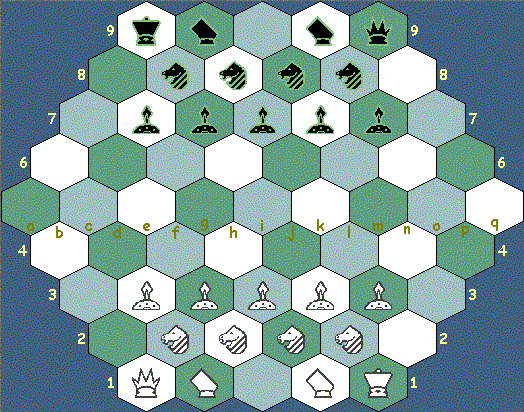 |
||
| White | Black | |
|---|---|---|
| e1, g1, i1, k1, m1 | 5 Soldiers | e9, g9, i9, k9, m9 |
| f2, h2, j2, l2 | 4 Horsemen | f8, h8, j8, l8 |
| g1, k1 | 2 Gunnes | g9, k9 |
| e1 | 1 Princess | m9 |
| m1 | 1 Monarch | e9 |
Pieces
Soldier | 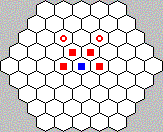 |
The Soldier may move one hex forward or sideways, but not backward. A Soldier may make a two-hex move forward, without changing directions, if both hexes are vacant. |
Horseman | 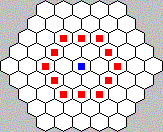 |
The Horseman may move exactly two hexes in any direction or combination of directions, ignoring any intervening piece. A Horseman may not end its move in the hex it came from, or in any hex adjacent to that hex. |
Gunne | 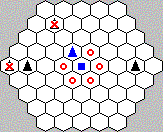 |
The Gunne may move without capturing one hex in any direction. A Gunne captures by sliding any clear distance in one of the six straight lines, leaping over exactly one piece of either color, and landing on the next piece in that line if it is an enemy piece. If a Gunne could capture a given enemy piece, it may do so by moving to that hex as usual. It may instead remain in its current hex and 'shoot' the enemy from a distance, removing the enemy without moving. |
Princess | 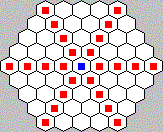 |
The Princess may slide any distance in one of the six straight lines. If the Princess is captured, the game is lost. (It is not illegal to leave the Princess vulnerable to capture; if you snooze, you lose.) |
Monarch | 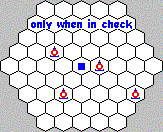 |
The Monarch may not move unless he is immediately threatened with capture by an enemy piece ('in check'). If in check, the Monarch may swap positions with another friendly piece not so threatened. If no move by any friendly piece will take the Monarch out of check, the game is lost. |
Rules
The rules of Panal are like those of orthodox Western chess, except as described above. Note that stalemate is impossible, and it is hard to conceive a draw by repetition except through inattention.
Notes
The original idea of Panal was for three players on a 91 hex board. The double royal piece feature remains from that conception.
Correspondences to traditional hexagonal games:
- The Soldier is modified from the traditional hexagonal pawn, as the 60 degree turn of the grid means there are only two forward directions instead of three.
- The Horseman is the hexagonal equivalent of a DF in Betza notation, combining a dabbabah (exactly two 'orthogonally') and a ferz (exactly one 'diagonally').
- The Gunne's non-capturing move is the hexagonal equivalent of a wazir. The Gunne's capturing move (ignoring the shooting variation) is the hexagonal equivalent of the Chinese pao, or cannon.
- The Princess moves like a traditional hexagonal rook.
Playing Tips
Soldiers are defensive in nature. They are a bit more mobile than traditional pawns, but don't promote. A common use is to set up shot lines for the Gunnes to attack.
Horsemen are probably a bit more powerful than Gunnes--certainly so in the endgame. Two or three coordinated Horsemen can threaten a terrifying number of hexes.
Gunnes offer a lot of options early. They often surprise the unwary...check out the double pin on move 3 of the sample game. Discovered attacks are commonplace, and the ability to remove targets without advancing can devastate a position. But as the board empties the Gunne loses force.
The Princess has the most powerful move of all, yet is limited by her royal status. Using her to attack the enemy Monarch down the open board edge early is always tempting, and timed correctly can be powerful.
Computer Play
If you have Zillions of Games installed on your computer, you can play this game. Download file: panal.zip.Equipment
A satisfactory set of Panal pieces can be assembled from one colored 'stash' of 15 Icehouse pyramids. Use the five small pyramids as Soldiers, and four of the five mediums as Horsemen. The Gunnes are large pyramids, the Princess is a medium stacked on a large, and the Monarch is two stacked larges.
Substituting regular chess pieces will also work, especially if two matching sets are available.
There are a lot of published games now that use some type of hex grid, so it should not be difficult to adapt a board. The coloring has no bearing on play, although it does make using the notation shown much easier.
Sample Game
Long algebraic notation is best for Panal, as often more than one friendly Horseman or Soldier can reach the same hex.
| WHITE | BLACK | |
|---|---|---|
| Move | Isabella | Ferdinand |
| 1 | Si3-g5 | Si7-h6 |
| 2 | xm7 | xm3 |
| These moves are shooting captures. If the Gunne had actually moved to capture the notation would be Gg1xm7 or Gg9xm3, respectively. | ||
| 3 | Sg5xh6 | Gh9xh6 |
| The recapture with the Gunne moving creates a double pin. Neither the Soldier at k3 nor the Horseman at l2 may leave the line between the Gunne and the White Monarch. Spotting the potential of Gunnes is a skill acquired with play. | ||
| 4 | Hj2-j4 | xk3 |
| The White Horseman temporarily relieves the pins, and attacks the advanced Gunne. Black grabs the Soldier. | ||
| 5 | Hj4xh6 | Hj8xh6 |
| 6 | Hh2-k3 | ... |
| White accepts further material disadvantage to break the pressure on the Monarch. The h2 Horseman then heads for the right flank to defend against the Black Princess attacking on that flank--a not uncommon theme. | ||
| 6 | ... | Pm9-q5+ |
| 7 | Hl2-o3+ | Pq5-p4 |
| Emboldened by a material plus, Black presses a bit too hard. Note the use of the + for check at White's seventh move attacking the Princess. | ||
| 8 | Hk3-m5+ | Pp4-n4?? |
A retreat to n6 is far better. Position after 8...Pp4-n4: 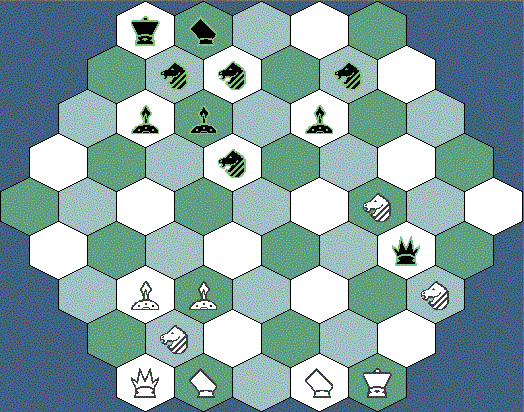 |
||
| 9 | Hf2-i3!! | Resigns (1:0) |
| Nothing can stop White's Hi3-l2+, fatally trapping the Princess. | ||
Written by Glenn Overby II.
WWW page created: May 18, 2003.